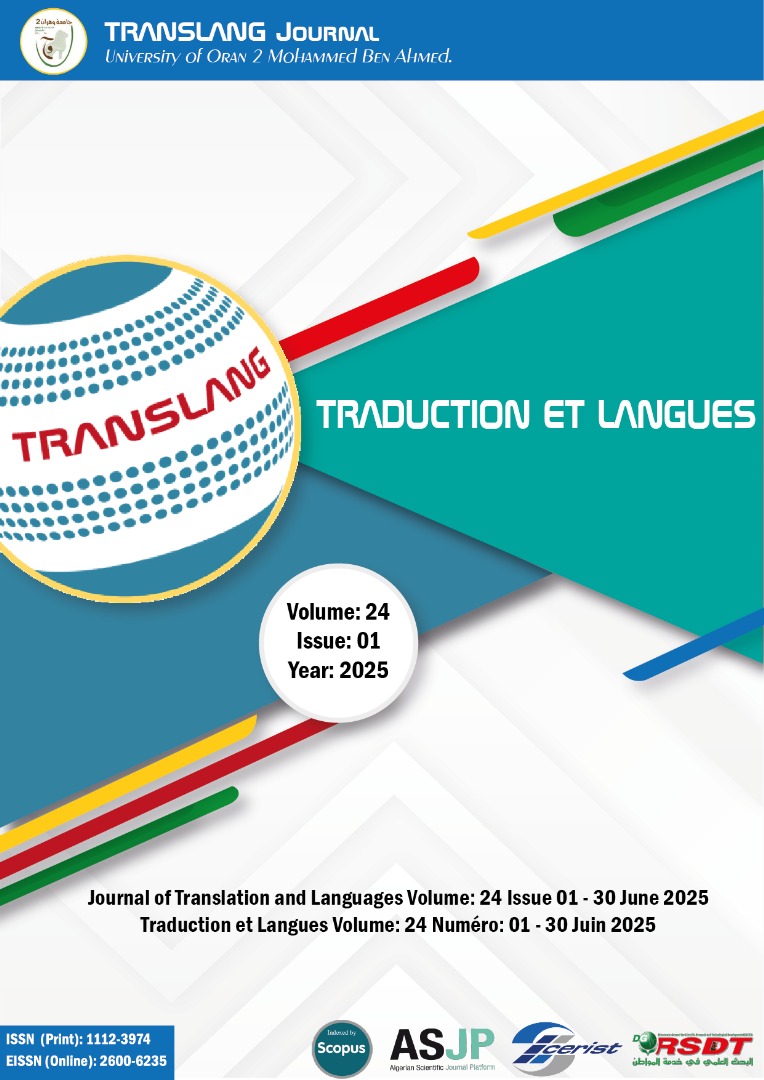Le Traducteur, Re-créateur du Texte Littéraire The Translator, A Recreator of Literary Texts
Main Article Content
Abstract
This study explores the creative dimension of literary translation by examining how translators move beyond mere stylistic reformulation to engage in a profound reinterpretation of the source text. The central research question addresses the following: to what extent does literary translation constitute a re-creative act, and how can the translator preserve the essence of the source text while introducing interpretative agency? Anchored in a translation studies framework, the paper proposes that translation, particularly of poetic texts, demands not only linguistic competence but also cognitive flexibility, aesthetic sensitivity, and interpretative insight. To investigate this hypothesis, the study adopts a qualitative, text-based methodology, grounded in close reading and comparative textual analysis. The object of analysis is Conte, a prose poem by French poet Arthur Rimbaud, selected for its richness in rhythm, imagery, and tonal ambiguity. The study examines the interplay between source and target texts by identifying moments of semantic density, phonetic patterning, and rhetorical complexity. Particular attention is paid to how the translator interprets and reconfigures these features in the target language, thus enacting a form of literary re-creation. The findings show that the translator’s engagement with the text is not limited to a passive transfer of meaning but involves a dynamic process of appropriation, reformulation, and stylistic negotiation. The act of translation becomes a site of co-authorship, where the translator’s reading is filtered through personal impressions, intertextual references, and cultural knowledge. Each translation choice reflects a balance between fidelity and transformation, positioning the translator as both reader and creator. This study argues for a reconceptualization of the translator’s role, challenging traditional models of translation as interlingual equivalence. Instead, it posits a model in which the translator functions as a re-creator, responsible for generating a target text that resonates with the original while asserting its own artistic legitimacy. The case of Conte reveals that creative translation is not a deviation from fidelity, but a mode of textual engagement that brings new life to literary works across linguistic boundaries.
Metrics
Article Details
References
Blanchot, M. (1988). L’espace littéraire (Coll. Folio Essais). Paris: Gallimard.
Cary, E. (1986). Comment faut-il traduire ? (2e éd. revue et corrigée). Presses Universitaires de Lille.
Ballard, M. (1998). Les « Mauvaises lectures » : étude du processus de compréhension. Dans J. Delisle & H. Lee-Jahnke (dir.), Enseignement de la traduction et traduction dans l’enseignement (p. 27-47). Les Presses de l’Université d’Ottawa.
Barthes, R. (1998). Le bruissement de la langue. Editions du Seuil.
Barthes, R. (2002). Œuvres complètes : Livres, textes, entretiens (Tome IV, 1972-1976, p. 1046, E. Marty, Dir.). Éditions du Seuil.
Bernard, S. (1978). Le poème en prose de Baudelaire jusqu’à nos jours. Librairie Nizet.
Brossard, N. (2016). OPAYSAGES : ou la partie invisible des mots. Dans C. Montini (Dir.), Traduire, genèse du choix (p. 171). Éditions des Archives Contemporaines.
Collot, M. (1997). La matière-émotion. Paris: Presses Universitaires de France.
Delisle, J. (1980). L'analyse du discours comme méthode de traduction. Éditions de l'Université d'Ottawa.
Deshusses, P. (2010). Le traducteur est un écrivain. Dans Le nouveau bulletin de l’ADEAF, numéro spécial « Traduction », n° 110, p. 6-8.
Eco, U. (2015). Lector in fabula – Le rôle du lecteur (M. Bouzaher, Trad.). Le Livre de Poche.
Foucault, M. (1994). Des espaces autres. Dans Dits et écrits (Tome IV : 1980-1988). Gallimard.
Gallagher, J. D. (2007). L’activité traduisante comme domaine de créativité. Dans A. Kaladi et C. Wecksteen (Dir.), La traductologie dans tous ses états (p. 284). Artois Presses Université.
Johnson, M., & Lakoff, G. (2003). Metaphors We Live By. The University of Chicago Press.
Israël, F. (1990). Traduction littéraire et théorie du sens. Dans M. Lederer (dir.), Etudes traductologiques en hommage à Danica Seleskovitch (pp. 29-43). Lettres modernes Minard.
Israël, F. (1994). La créativité en traduction ou le texte réinventé. Dans M. Raders et R. Martin-Gaitero (Dir.), IV Encuentros Complutenses en torno a la traducción (pp. 105-118). Editorial Complutense.
Jouve, V. (1992). L’effet-personnage dans le roman. Presses Universitaires de France.
Ladmiral, J.-R. (1994). Traduire : Théorèmes pour la traduction. Paris : Gallimard.
Lederer, M. (2006). La traduction aujourd’hui : Le modèle interprétatif. Hachette.
Malraux, A. (2004). Les voix du silence. Gallimard.
Melançon, J. (Dir.). (1992). Les métaphores de la culture. Les Presses de l’Université Laval.
Meschonnic, H. (1999). Poétique du traduire. [Poetics of the Translation Process]. Verdier.
Morin, E. (2014). Introduction à la pensée complexe. ESF.
Plassard, F. (2007). Lire pour traduire. Les Presses de la Sorbonne Nouvelle.
Proust, M. (1989). À la recherche du temps perdu (Tome IV). Bibliothèque de la Pléiade.
Ricœur, P. (1997). La métaphore vive. Éditions du Seuil.
Ricœur, P. (2004). Sur la traduction. Bayard.
Rimbaud, A. (2023). Conte. Dans Poésies. Une saison en enfer. Illuminations (pp. 211-212). Gallimard.
Seleskovitch, D. (1987). Traduction technique et traduction littéraire, différence ou opposition ? Traduire, (134), 88–101.
Stanislavski, C. (2021). La formation de l’acteur (É. Janvier, Trad.; J. Vilar, Préf.). Paris : Payot.
Todorov, T. (2002). Mikhaïl Bakhtine - Le principe dialogique suivi de Écrits du Cercle de Bakhtine. Seuil.
Centre National de Ressources Textuelles et Lexicales. (n.d.). Prince - Étymologie. CNRTL. Retrieved December 7, 2024, from https://www.cnrtl.fr/etymologie/prince
Centre National de Ressources Textuelles et Lexicales. (n.d.). Texte - Étymologie. CNRTL. Retrieved December 7, 2024, from https://www.cnrtl.fr/etymologie/texte
Centre National de Ressources Textuelles et Lexicales. (n.d.). Vulgaire - Étymologie. CNRTL. Retrieved December 7, 2024, from https://www.cnrtl.fr/etymologie/vulgaire
Larousse. (n.d.). Impressionnisme. Larousse. Consulté le [19/11/2024], sur https://www.larousse.fr/encyclopedie/divers/impressionnisme/187117.
Wuilmart, F. (2012). La voix du texte : Nietzsche à l’écoute de Fonagy ? Revue SEPTET. http://www.traduction-litteraire.com/articles/la-voix-du-texte/
